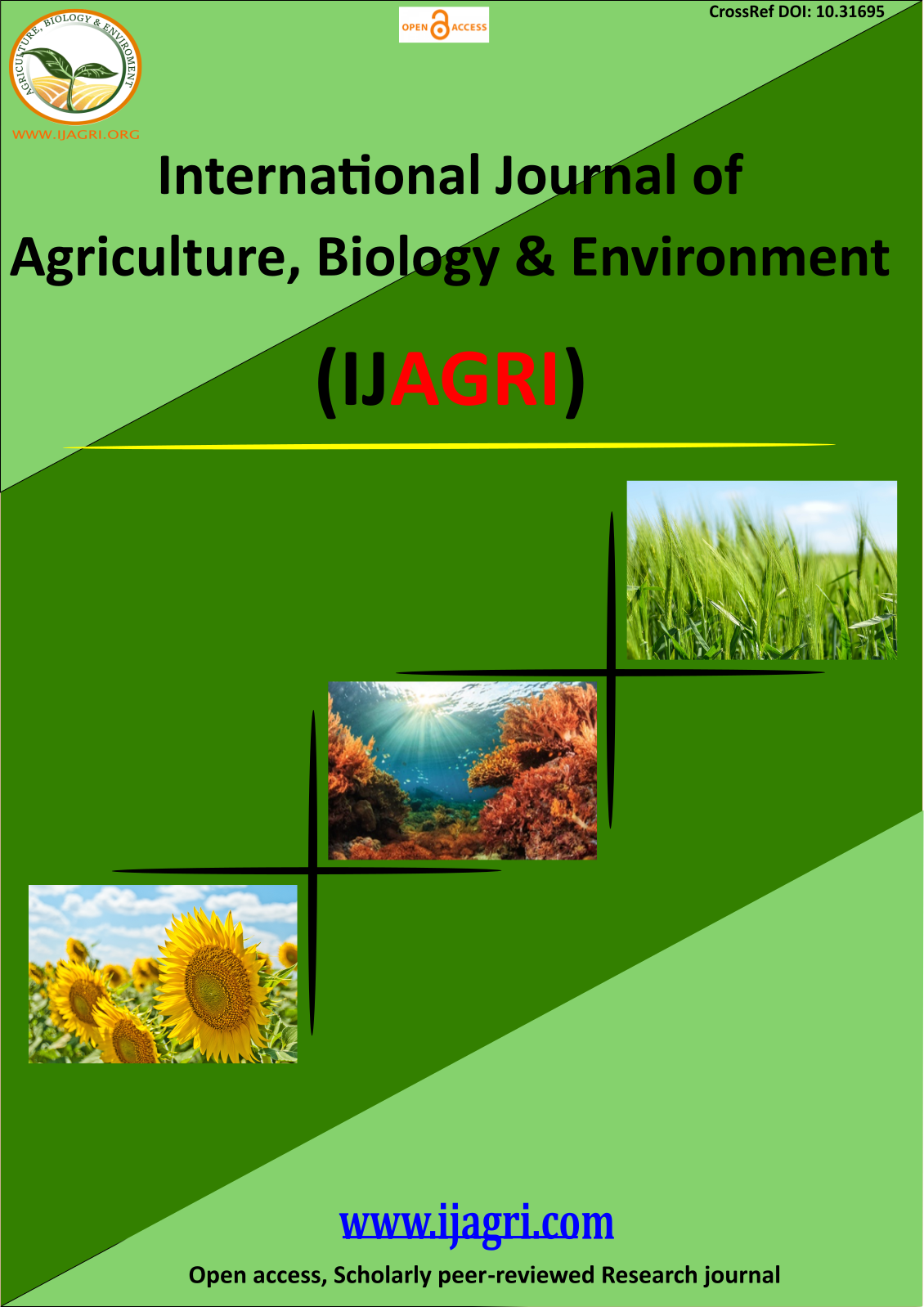Impact of Water Salinity on upland Cotton Genotypes at Seedling Growth Stage
DOI:
https://doi.org/10.47504/IJAGRI.2025.2.1Keywords:
Cotton Genotype, Dry Weight, Fresh Weight, Tolerance, Salinity, SeedlingAbstract
Expansion of cotton in saline areas of Bangladesh requires to identify cotton genotypes that can thrive under saline environment. The study was performed to identify salinity tolerance cotton genotypes at seedling growth stage in 2019 at Salinity Management and Research Center, Batiaghata, Khulna, Bangladesh. Eight cotton genotypes namely CB-12, CB-14, CB- Hybrid-1, Rupali-1, DM-2, JA-17/6, JA-17/5 and JA—17/7 were evaluated under six saline 5, 10, 15, 20, 25 and 30 dS m-1 and one non-saline (control) condition. The experiment was conducted in a completely randomized design (CRD) with three replications. Different water salinity used in this study significantly influenced the growth of cotton genotypes. Under the growth at 30 dS m-1, the less reduction of root length was in genotype JA-17/7 (44%), root fresh weight and dry weight of root were reduced lowest of 42% in CB Hybrid-1, the lowest reduction of shoot length of 37% was recorded in genotype JA-17/6, the genotype Ja-17/5 showed the lowest decrease fresh weight of shoot of 45% and the decrease of the dry weight of shoot was lowest in genotype JA-17/5 and JA-17/6. The genotype CB-14, CB Hybrid-1, Rupali-1, JA-17/6, JA-17/5 and JA-17/7 were identified as the moderately tolerant genotype against salinity based on relative performance of growth under the salinity level of 20 dS m-1. These genotypes have the potentiality to grow under salinity stress condition.
Downloads
References
Ahmed, R., Howlader, M. H. K., Shila, A., & Haque, M. A. (2017). Effect of salinity on germination and early seedling growth of maize. Progressive Agriculture, 28 (1) 18-25.
Aslam, R., Bostan, N., Nabgha-e, A., Maria, M., & Safdar. W. A. (2011). Critical review onhalophytes: salt tolerant plants. Journal of Medical Plants Research, 5 7108–7118.
Azad, M. A. K., Alam, M. S., & Hamid, M. A. (2013). Modification of salt tolerance level in groundnut (Arachis hypogaea L.) through induced mutation. Legume Ressearch 36(3) 224-233.
Bilal, M., Abbas, Z., Ahmad, I., Aslam, M., Ijaz, M., Adnan, S., Shakeel, A., Mushtaq, A., & Bashir, K. (2016). Response of different cotton genotypes at various salinity levels Gossypium hirsutum Pakistan Journal of Agricultural Research 29 (4) 347-354.
Dever, J. K., Morgan, V., Kelly, C. M., Wheeler, T. A., Elkins, H., Mendoza V., & Arce, J. (2015). Cotton Performance Tests in the Texas High Plains 2014. Texas A&M Agri Life Research Technical Report 15 (1) 19.
Elkins, H. D. (2017). Cotton, Gossypium Hirsutum L., Cultivars Differential Response to Salinity, MS Thesis, Department of Plant Breeding, Texas A & M University, USA.
Haque, M. A., Jahiruddin, M., Hoque, M. A. Rahman, M. Z., & Clarke, D. (2014). Temporal variability of soil and water salinity and its effect on crop at Kalapara upazila. Journal of Environmental Science and Natural Resources, 7(2) 111-114.
ICCCAD (2018). The International Centre for Climate Change and Development, Climate-resilient agriculture in Bangladesh: A value chain analysis of cotton, Dhaka, Bangladesh.
Iqbal, M. M., Khan, T. M., Iqbal, M. S., & Khan, A. H. (2013). Estimation of Genetic potential for tolerance in Gossypium hirsutum L. Journal of Agricultureal Ressearch. 51(4). 379-302.
Meloni, D. A., Oliva, Maruiz, H. A., & Martinez, C. A. (2001). Contribution of proline and inorganic solutes to osmotic adjustment in cotton under salt stress. Journal of Plant Nutrition, 24(3) 599-612.
Munis, M. F. H., Tu, L., Ziaf, K., Tan, J., Deng, F., & Zhang, X. (2010) Critical osmotic, ionic and physiological indicators of salinity tolerance in cotton (Gossypium hirsutum L.) for cultivar selection. Pakistan Journal of Botany, 42(3) 1685-94.
Rauf, A., Zaki, M. J., & Khan, D. (2014). Effects of NaCl salinity on growth of some cotton varieties and the root rot pathogens. International Journal Biology and Biotechnology, 11 (4) 661-670.
Rezaee, S., Moghaddam, M. R. R., & Bazrgar, A. B. (2015). Cotton seed germination as affected by salinity and priming. Indian Journal of Fundamental and Applied Life Sciences, ISSN 2231– 6345 (Online) at http://www.cibtech.org/jls.htm
Shaheen, H.L., Shahbaz, M., Ullah, I., and Iqbal, M. Z. (2012) Morpho-physiological responses of cotton (Gossypium hirsutum) to salt stress. International Journal of Agriculture and Biology, 14 980?984.
Zhang, L., Ma, H., Chen, T., Pen, J., Yu, S., & Zhao, X. (2014). Morphological and Physiological Responses of Cotton (Gossypium hirsutum L.) Plants to Salinity. PLOS One. 9(11) e112807 https : //doi.org/10.1371/journal.pone.0112807
Downloads
Published
Issue
Section
License
Copyright (c) 2025 Kamrul Hassan, Md. Abul Hashem; Farid Uddin

This work is licensed under a Creative Commons Attribution-NonCommercial 4.0 International License.





2.png)






